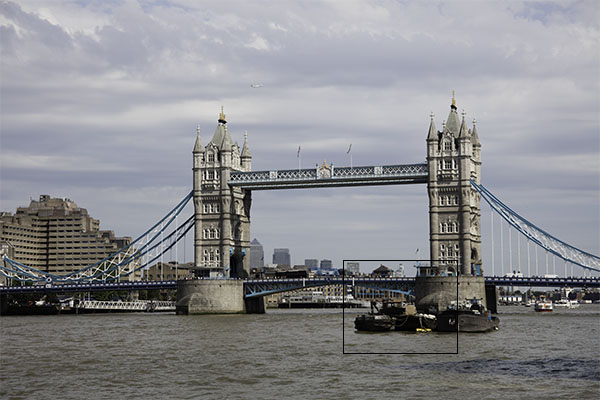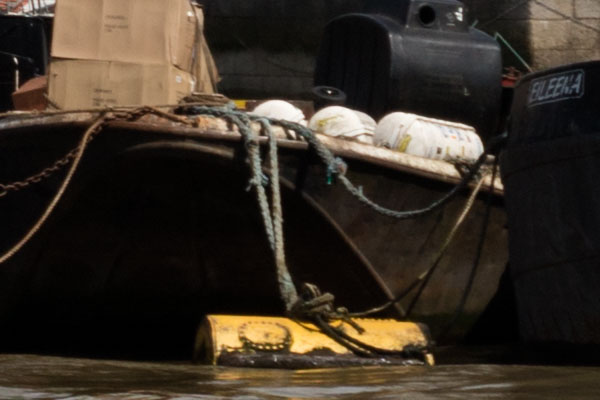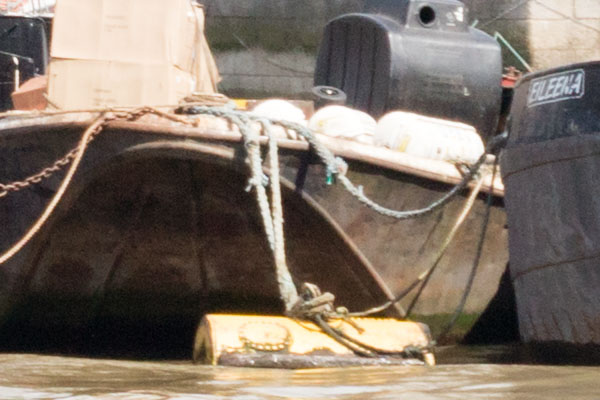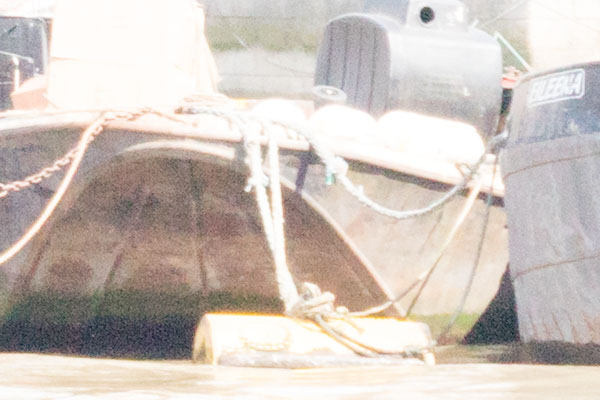(Note: The images were not included in the original post, which instead included text links only. The images are now part of the post.)
I just took a break and had time to play with a Canon 5Ds raw file that I found on the web. (Anyone wanting to look at files from the 5Ds should head on over to that link right now — there are something like 90+ files to look at.) It was made with the 5Ds at ISO 100, f/8, 1/400 second. It isn’t clear what lens was used, but it appears that it could have been either the 50mm f/1.8 STM lens or the 24-70mm f/2.8 II.
I opened the file in ACR. I made no adjustments to curves, color, etc. I let ACR automatically correct for CA. Default ACR sharpening used at 15 with masking at 50.
I brought the converted file into Photoshop as a smart object to allow for non-destructive re-editing in Adobe Camera Raw (ACR). I confirmed that shadow areas along the waterline of the boats have luminosity values of 0 — I did this by checking the Lab color representation and watching the L value, which hits 0 in several spots. The general area is shown by the rectangle in the following image:

Here are five versions of a 600 x 400 pixel crop including this area of the scene. All are 100% magnification crops. They are as follows:
- original exposure.

- “exposure” slider raised by 1.00.
- “exposure” slider raised by 2.00.
- “exposure” slider raised by 3.00.
- “exposure” slider raised by 4.00.
- “exposure” slider raised by 5.00.
Each successive image was made by reopening the smart object in ACR and readjusting the “exposure” slider one full value higher, which is essentially the same thing in ACR as adjusting the same slider in Lightroom (LR).
Each image was converted to 8-bit jpg and the sRGB color space. No sharpening or additional processing was applied in ACR or in Photoshop.
For fun, here is a small version of the full final image with exposure at +5.00
I have no evidence that the 5Ds equals or exceeds the low noise or dynamic range capabilities of the Sony sensors, and no one has made such a claim — to the contrary, it seems like the new Canon sensor will likely have somewhat less dynamic range than current Sony sensors found in cameras from Sony, Nikon, and others. That said, everything I’ve seen so far suggests that the 5Ds sensor will work very well and that noise isn’t likely to be any problem. I hope this set of images may help quantify the meaning of this and the actual ability of the 5Ds sensor.
5Ds and 5Ds R Articles:
- The Canon EOS 5Ds R — Autofocus Torture Test
- The Canon EOS 5Ds R — Dynamic Range Examples
- The Canon EOS 5Ds R — A Resolution Example
- Canon 5DS R: A Printing Test
- Looking at Canon 5Ds RAW Files: Noise and Dynamic Range.
- Canon EOS 5Ds and 5Ds R Release Near?
- Canon 5Ds and 5Ds R Pre-orders Available
(You may use the links in this paragraph to order/reserve either the 5DS or the 5DS R from site-sponsor B&H photo. I have reserved mine — I’m going with the “R” model.)
 G Dan Mitchell is a California photographer and visual opportunist. Blog | About | Flickr | Twitter | Facebook | Google+ | 500px.com | LinkedIn | Email
G Dan Mitchell is a California photographer and visual opportunist. Blog | About | Flickr | Twitter | Facebook | Google+ | 500px.com | LinkedIn | Email
All media © Copyright G Dan Mitchell and others as indicated. Any use requires advance permission from G Dan Mitchell.






